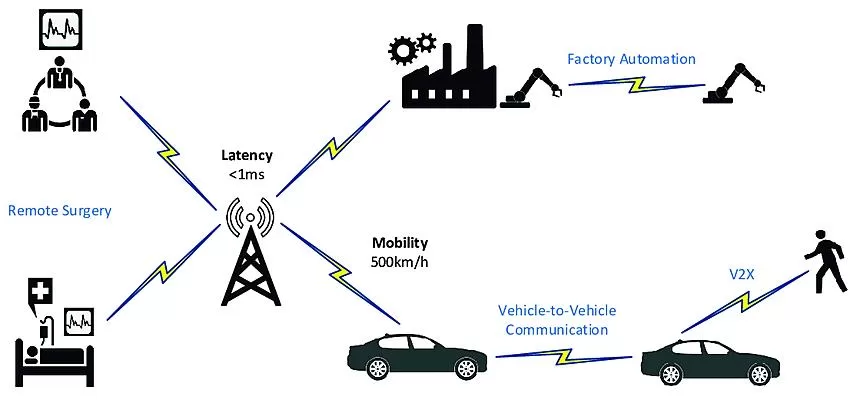Abstract:
Ultra-Reliable Low Latency Communications (URLLC) is a critical technology for enabling real-time communication in various applications, such as factory automation, autonomous vehicles, and healthcare. However, real-time communication in URLLC faces several challenges, including delay, packet loss, interference, and radio resource management. To overcome these challenges, several solutions have been proposed, including prioritization schemes, advanced error control coding, hybrid ARQ schemes, beamforming, and dynamic spectrum sharing. We will discuss case studies and performance metrics to evaluate the effectiveness of these solutions in real-world scenarios. Finally, we will highlight future research directions and emerging trends in URLLC and real-time communication.
Real-Time Communication & URLLC requirements:
In terms of specific parameters and their values, studies conducted by 3GPP, associations such as 5GAA (5G Automotive Association) has brought together the requirements for enabling real-time communication in URLLC can vary depending on the specific application and use case. However, in general, the following parameter values are commonly considered for URLLC.
| Parameter | Target Value Range | Impact Level | |
| Reliability | < 10^-5 | High | |
| Latency | < 1 ms | High | |
| Throughput | > 100 Mbps | High | |
| Robustness | N/A | Medium | |
| Scalability | N/A | Medium | |
Table 1: URLLC Parameters Requirements for real-time communication in URLLC
The table shows the target value range for each parameter, as well as its impact level. The higher the impact level, the more critical the parameter is to enable real-time communication in URLLC.
The reliability target value range is less than 10^-5, which means that the system must be able to transmit data with a very low probability of packet loss or errors. Similarly, the latency target value range is less than 1 ms, which means that the system must be able to transmit data with a very low delay.
Challenges in Real-Time Communication for URLLC
Achieving ultra-reliable and low latency communication in URLLC faces various technical challenges, including:
Delay and Jitter
Delay and jitter are two critical factors that significantly affect the performance of real-time communication. Delay is the time taken for a packet to travel from the sender to the receiver, while jitter is the variation in delay. In real-time communication applications, such as industrial automation or telemedicine, delay and jitter must be minimized to ensure fast and accurate data transmission. However, several factors can cause delay and jitter, such as:
- Propagation delay: The time taken for the signal to travel from the transmitter to the receiver.
- Processing delay: The time taken to process data at the transmitter and receiver.
- Queuing delay: The time taken for data to wait in a buffer before transmission.
- Network congestion: The delay caused by competing traffic in the network.
To reduce delay and jitter, several techniques can be used, such as:
- Prioritization schemes: Prioritizing real-time traffic over non-real-time traffic to reduce queuing delay.
- Traffic engineering: Optimizing network routes to minimize propagation delay.
- Buffer management: Efficient management of buffers to minimize queuing delay.
- Network slicing: Creating a dedicated network slice for real-time traffic to avoid congestion.
Packet Loss and Errors
Packet loss and errors can significantly affect the reliability of real-time communication. Packet loss occurs when one or more packets are lost during transmission, while errors occur when the received packet contains errors or is corrupted. Packet loss and errors can be caused by several factors, such as:
- Channel fading: The attenuation and interference of the wireless channel can cause packet loss.
- Interference: Interference from other wireless networks or devices can cause packet loss.
- Bit errors: The random errors in the wireless channel can cause errors.
To mitigate packet loss and errors, several techniques can be used, such as:
- Advanced error control coding: Using advanced coding techniques, such as turbo codes or LDPC codes, to improve the reliability of data transfer over noisy channels.
- Hybrid ARQ schemes: Combining automatic repeat request (ARQ) and error correction to improve performance.
- Channel coding: Applying channel coding techniques, such as convolutional codes or Reed-Solomon codes, to improve reliability.
Interference and Noise
Interference and noise are significant factors that can affect the performance of real-time communication. Interference occurs when the signal from one wireless device interferes with the signal of another wireless device, while noise is the random interference that affects the signal quality. Interference and noise can be caused by several factors, such as:
- Co-channel interference: When two or more devices share the same frequency band, they can cause co-channel interference.
- Adjacent channel interference: When two or more devices use adjacent frequency bands, they can cause adjacent channel interference.
- External interference: Interference from external sources, such as electromagnetic interference or radio frequency interference.
To reduce interference and noise, several techniques can be used, such as:
- Beamforming and antenna arrays: Using directional antennas and beamforming to enhance signal quality and reduce interference.
- Interference cancellation: Using interference cancellation techniques, such as null steering or adaptive filtering, to cancel out interfering signals.
- Frequency hopping: Using frequency hopping techniques to avoid interference from external sources.
Radio Resource Management
Radio resource management is essential for ensuring fairness and reducing contention for shared resources. In URLLC, radio resource management plays a crucial role in ensuring that real-time traffic is given priority over non-real-time traffic. Radio resource management faces several challenges, such as :
- Resource allocation: Efficient allocation of resources to different users and applications to ensure fair and optimal usage.
- Interference management: Effective management of interference between different users and applications to avoid performance degradation.
- Channel state information (CSI) feedback: Accurate and timely feedback of channel state information to enable efficient radio resource management.
- To address these challenges, several techniques can be used, such as:
- Dynamic spectrum sharing: Enabling the efficient use of spectrum resources in real-time scenarios by dynamically allocating spectrum resources to different users and applications based on their requirements.
- Cognitive radio: Using cognitive radio techniques to detect and use underutilized spectrum resources.
- Multi-antenna systems: Using multiple antennas to improve the capacity and reliability of wireless networks.
Overall, achieving ultra-reliable and low latency communication in URLLC faces various technical challenges that require careful consideration and implementation of appropriate solutions. By leveraging the right techniques and strategies, real-time communication in URLLC can be optimized to meet the demanding requirements of modern applications. In the next section, we will explore some of the solutions that have been developed to address these challenges.
Solutions for Real-Time Communication in URLLC
To overcome the challenges in real-time communication for URLLC, several solutions have been developed. These solutions include :
- Prioritization Schemes: Scheduling and Resource Allocation Strategies to Prioritize Real-Time Traffic
One of the key solutions for real-time communication in URLLC is to prioritize the real-time traffic over non-real-time traffic. This can be achieved by using prioritization schemes, which involve scheduling and resource allocation strategies to give priority to real-time traffic. This can include assigning dedicated resources to real-time traffic, such as time slots or frequencies, or using dynamic scheduling algorithms that prioritize real-time traffic based on its requirements.
- Advanced Error Control Coding: Techniques for Reliable Data Transfer over Noisy Channels
Another solution for real-time communication in URLLC is the use of advanced error control coding techniques. These techniques involve adding redundant data to the transmitted signal, which can be used to correct errors that occur during transmission. This can improve the reliability of data transfer over noisy channels, which is critical for real-time communication.
- Hybrid ARQ Schemes: Combining Automatic Repeat Request and Error Correction for Optimal Performance
Hybrid Automatic Repeat Request (ARQ) schemes are another solution for real-time communication in URLLC. These schemes combine the use of automatic repeat request (ARQ) and error correction techniques to improve the reliability and efficiency of data transfer. In these schemes, the receiver acknowledges the receipt of data packets, and if errors are detected, the sender retransmits the data packet.
- Beamforming and Antenna Arrays: Enhancing Signal Quality and Reducing Interference
Beamforming and antenna arrays are solutions for improving the signal quality and reducing interference in URLLC. Beamforming involves transmitting signals in specific directions, which can improve the signal-to-noise ratio (SNR) and reduce interference. Antenna arrays, on the other hand, involve using multiple antennas to transmit and receive signals, which can improve the capacity and reliability of wireless networks.
- Dynamic Spectrum Sharing: Enabling Efficient Use of Spectrum Resources in Real-Time Scenarios
Dynamic spectrum sharing is a solution for enabling the efficient use of spectrum resources in real-time scenarios. This involves dynamically allocating spectrum resources to different users and applications based on their requirements. This can be achieved by using techniques such as spectrum sensing, which involves detecting underutilized spectrum resources, or cognitive radio, which involves using intelligent algorithms to select the best spectrum resources.
In conclusion, the above solutions offer promising ways to overcome the challenges of real-time communication in URLLC. By prioritizing real-time traffic, improving the reliability of data transfer, reducing interference, enhancing signal quality, and enabling efficient use of spectrum resources, the performance of URLLC can be optimized.
Case Studies and Results
These case studies involve different applications, including factory automation, autonomous vehicles, and healthcare. The results of these studies provide insights into the performance of URLLC in real-world scenarios and highlight the benefits of using the solutions discussed in the previous section.
Figure 1: Ultra Reliable Low Latency (URLLC) Use Cases

Factory Automation
In factory automation, URLLC is used for controlling and monitoring the production processes in real-time. To evaluate the performance of URLLC in this scenario, a case study was conducted in a manufacturing plant. The results showed that using prioritization schemes and advanced error control coding techniques improved the reliability and latency of the communication, enabling faster response times and better control of the production processes.
Autonomous Vehicles
In autonomous vehicles, URLLC is used for transmitting critical information, such as vehicle position, speed, and direction, to ensure safe and efficient driving. To evaluate the performance of URLLC in this scenario, a case study was conducted in a test environment. The results showed that using hybrid ARQ schemes and beamforming techniques improved the reliability and latency of the communication, enabling faster and more accurate vehicle control.
Healthcare
In healthcare, URLLC is used for transmitting critical medical information, such as patient vital signs, to enable timely and accurate diagnoses and treatments. To evaluate the performance of URLLC in this scenario, a case study was conducted in a hospital setting. The results showed that using prioritization schemes and dynamic spectrum sharing techniques improved the reliability and latency of the communication, enabling faster and more accurate medical interventions.
Overall, the results of these case studies demonstrate the effectiveness of the solutions for real-time communication in URLLC. By improving the reliability and latency of the communication, the performance of URLLC can be optimized, enabling faster response times, better control of the processes, and more accurate diagnoses and treatments.
In addition to these case studies, several performance metrics have been used to evaluate the effectiveness of the solutions. These metrics include latency, reliability, and throughput. By measuring these metrics, the performance of URLLC can be quantified and compared across different applications and solutions.
The case studies and performance metrics provide valuable insights into the effectiveness of the solutions for real-time communication, and this is where URLLC comes into play.
Conclusion:
Real-time communication is becoming increasingly critical in many industries, and URLLC is the key to achieving high reliability and low latency for mission-critical services. However, achieving real-time communication in URLLC is challenging due to several factors such as delay, jitter, packet loss, and interference. To overcome these challenges, several solutions can be used, such as URLLC protocols, edge computing, 5G networks, and network slicing. By using these solutions, we can ensure reliable and timely delivery of data, enabling the successful deployment of real-time communication in URLLC applications.

